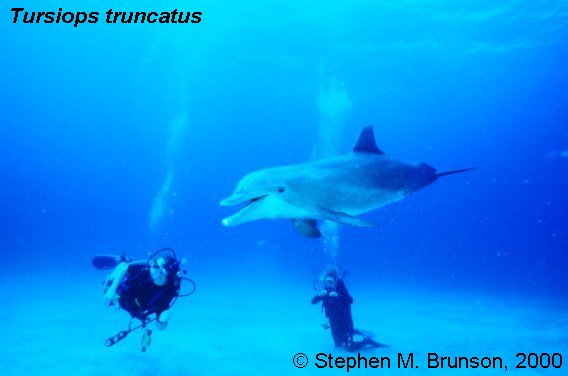








Bottlenose Dolphin: Tursiops truncatus
The Bottlenose Dolphin, Tursiops truncatus, is found in coastal waters around the world, is one of the best-known and most loved marine mammals. Coastal waters of the Atlantic, the temperate North Pacific, and the Red Sea and Indo-Pacific region are home to three species of bottlenose dolphin. Dolphins communicate by means of high-pitched whistles and clicks which create sound waves. The sound waves travel through the water and bounce off solid objects, causing an echo. A dolphin's brain is adapted to undersatand the echoes that travel though the water. By using this kind of echolocation, a dolphin can interpret a detailed "picture" of its environment, from which it is able to quickly identify the direction, size, and distance of prey.

Print Number - DOL018
Limited Edition signed color photography for sale by Stephen Brunson
Dolphin, Tursiops truncatus Statistics:
Weight: 330 - 440 lbs
Length: 11 - 13 Ft
Sexual Maturity: About 8 Years
Mating Season: Usually during the Summer
Lifespan: Up to 50 years
Typical Diet: Inshore Fish, such as Capelin, Anchovy, Salmon, and Shrimp
Number of Young: Single Calf
Related Species: There are about 40 species of Dolphin and their close relative, the Porpoise
Habit: Sociable and Playful
Language: Extensive Vocabulary of Whistles and Clicks
Danger to humans:
Dolphins seems to have a "sixth" sense in recognizing the handicapped, disabled or
physically challenged child (or adult) and gently encourages the child to interact by
slowly cruising and then offering its fin for the youngster to latch onto and gradually
swim or be pulled by the sensitive, patient and gentle cetacean.
Dolphins have been been used as a tool to treat people with other special needs,
such as cancer, meningitis, attention deficit disorder, spinal injuries, chronic pain,
etc. ( Dolphin Wellness Program )
BrunsonImages@att.net


















